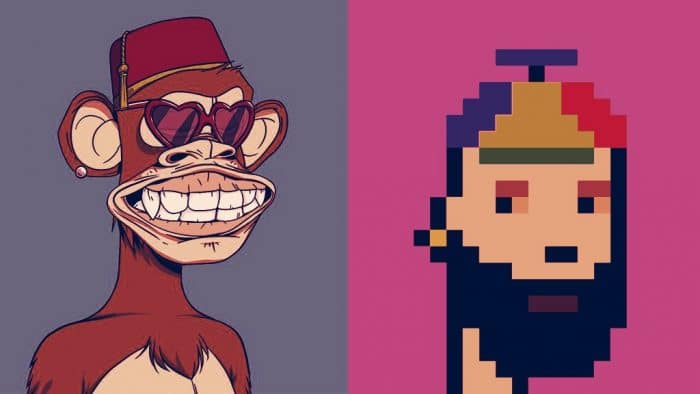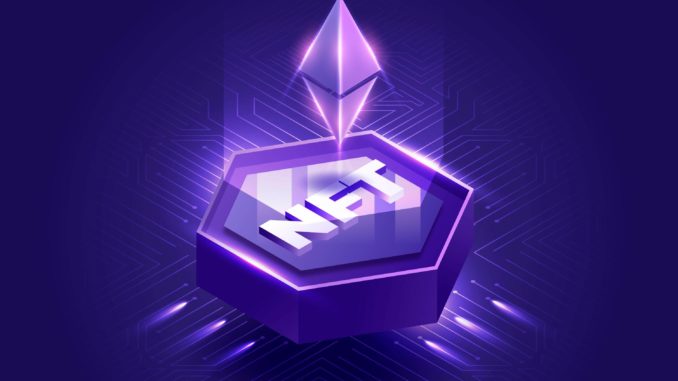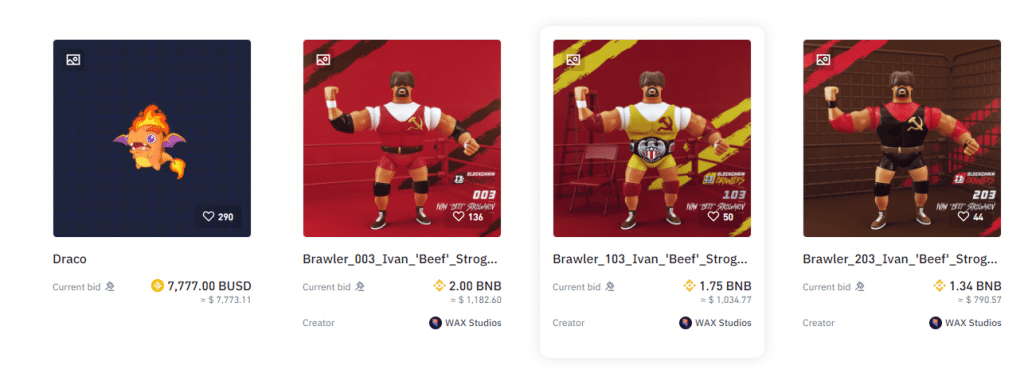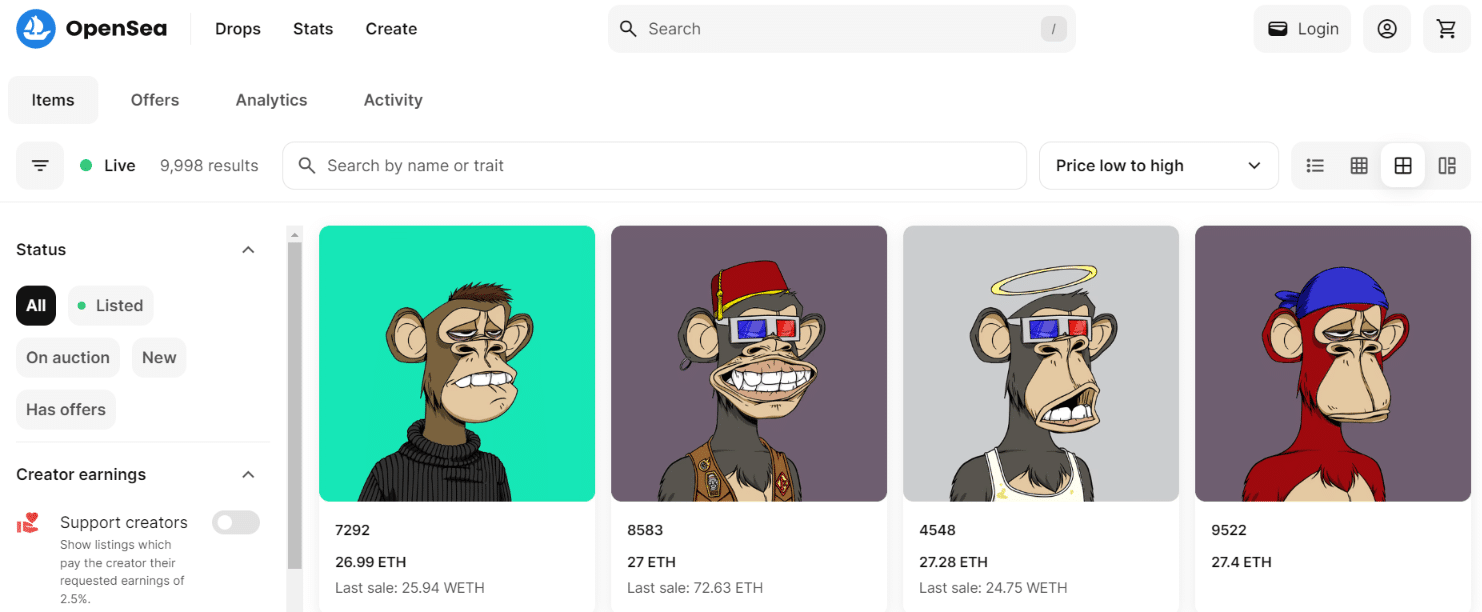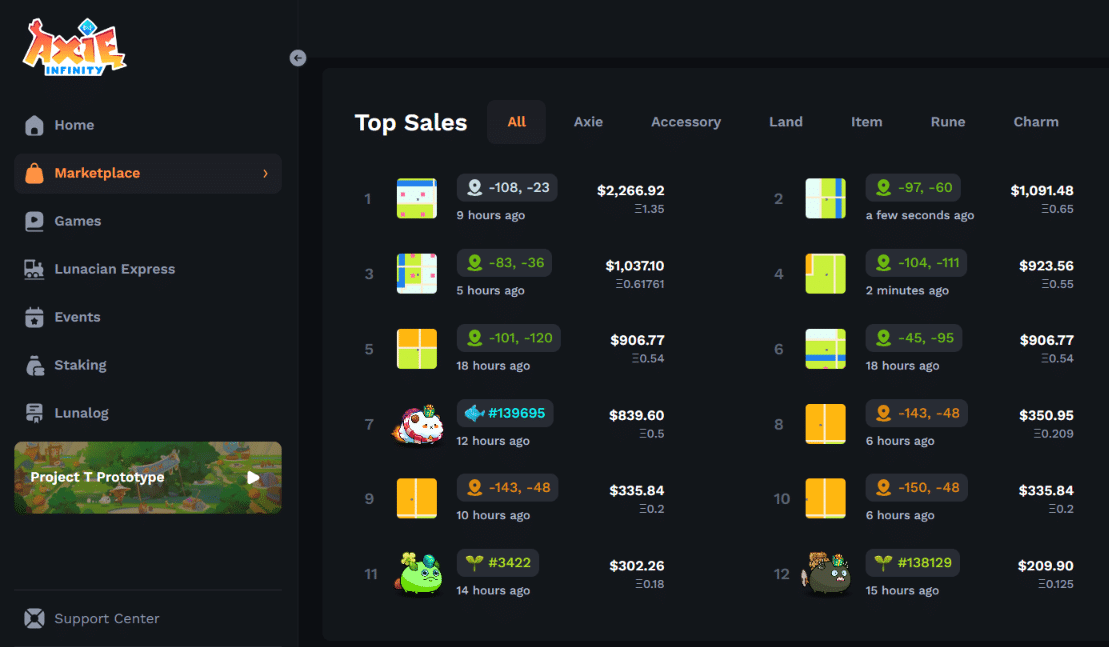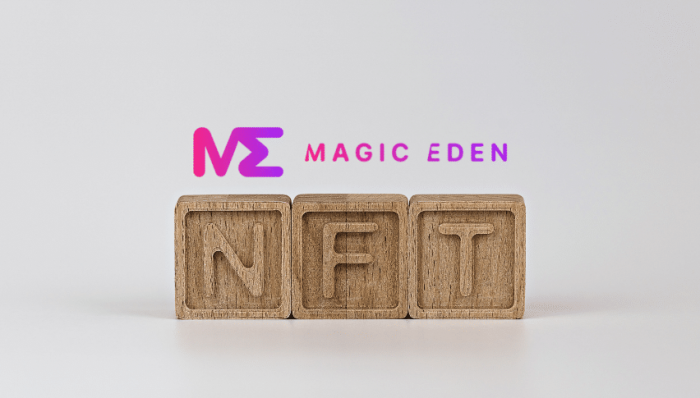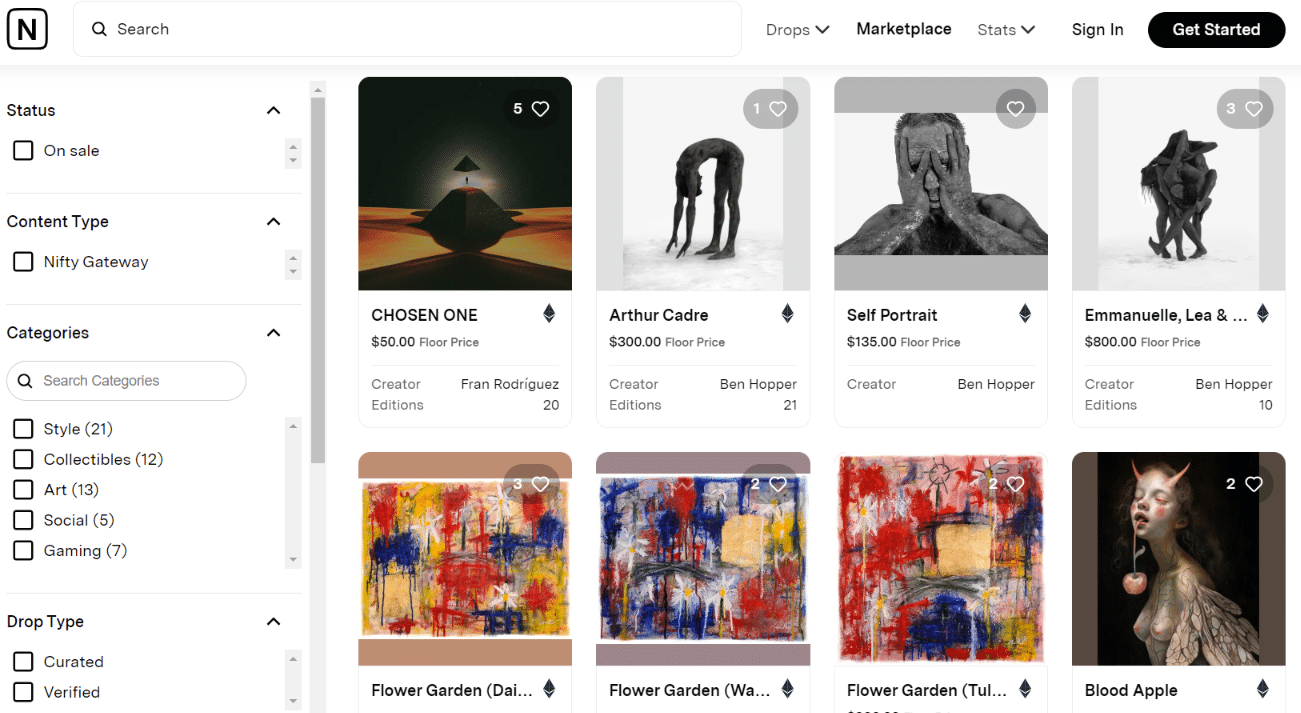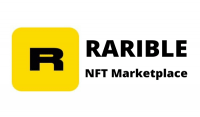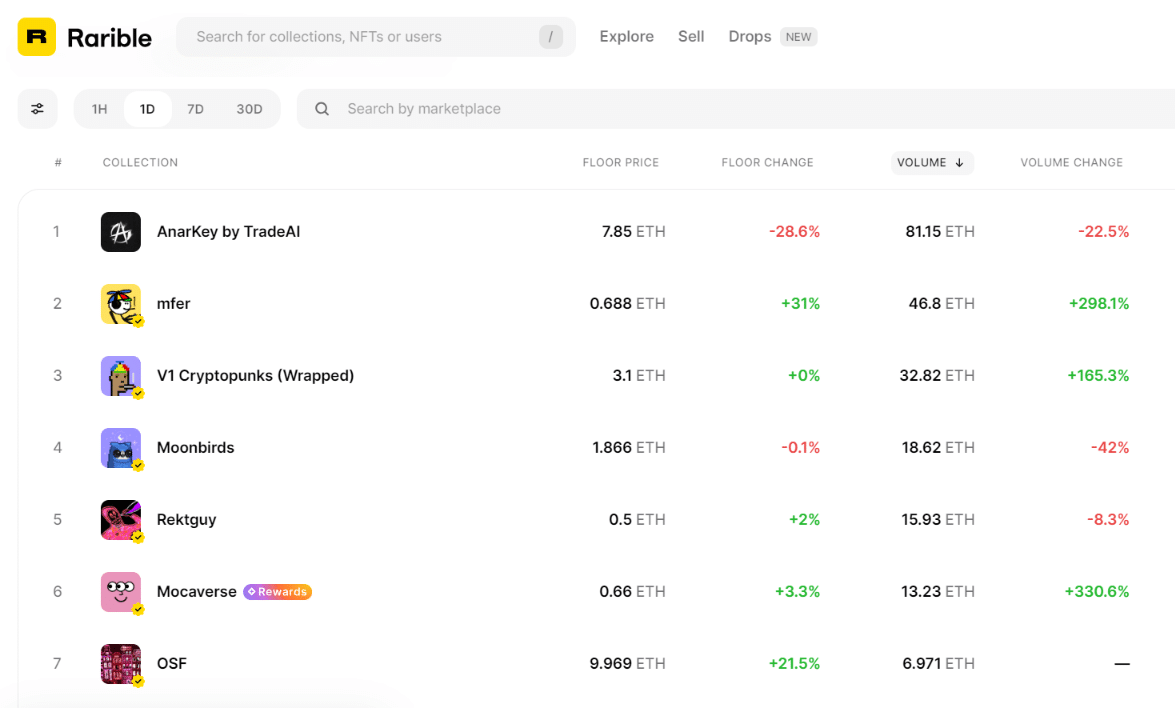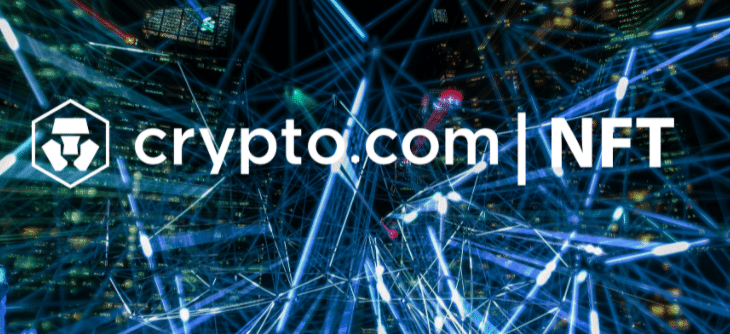7 Best NFT Marketplaces & Trading Platforms in June 2025
To participate in the NFT craze, you will need to find NFT trading platforms. You can purchase and sell digital assets with these trading apps, from art to music to entire virtual worlds. An NFT trading platform is like the digital world’s Amazon (NASDAQ: AMZN).
Numerous NFT marketplaces exist, as is well known, each of which has a unique focus. So when selecting an NFT trading platform, what are the factors you should consider? And what are the top NFT trading platforms? Read on to learn more about NFT trading.
-
-
7 Top NFT Marketplaces in 2025
- Binance NFT Marketplace: Binance is a well-known crypto exchange that also supports NFT trading on the Binance Smart Chain (BSC). Users can trade, mint, sell, purchase and bid on NFTs within the platform. Binance NFT marketplace is mainly used for digital art but supports a range of media types.
- OpenSea: A decentralized peer-to-peer (p2p) NFT marketplace that spans across the Ethereum, Polygon (Matic), Optimism and many other blockchain networks. NFT holders sell directly to each other, reducing the risk of third-party involvement.
- Axie Marketplace: The native NFT trading platform of the popular Axie Infinity game. Purchase, swap and sell valuable Axie NFTs with low fees. This marketplace is restricted to the game as opposed to other platforms.
- Magic Eden: Magic Eden is built on Solana (SOL). The platform can be used for traditional NFT trading and also supports NFT auctions and reselling.
- Nifty Gateway: Nifty Gateway is an exclusive NFT platform that supports high quality content that holds its value. Unlike other platforms, not everyone can list their work for sale. NFTs have to meet specific requirements and the platform focusses on supporting mainly ‘luxury’ NFTs.
- Rarible: Rarible is based on the Ethereum blockchain and is one of the most widely used NFT trading platforms. Collectors can purchase NFTs and creators can sell their work with ease.
- Crypto.com: Crypto.com offers zero fees for NFT transactions, which makes it stand out from other options. The platform also accepts various payment methods for buying NFTs.
The price or value of cryptocurrencies can rapidly increase or decrease at any time. You must be satisfied that this crypto offering is suitable for you in light of your financial circumstances and attitude towards risk.
What is an NFT?
NFT stands for non-fungible token. It is a collectible digital asset that is stored on blockchain technology. NFTs are made up from encrypted codes that are all entirely unique. No two NFTs can ever be the same.
NFTs come in a range of forms including digital artwork, music, games and other media. In fact, any digital object can be an NFT including tweets, song lyrics and even domain names. The purpose of an NFT is to prevent fraud and to give each digital asset real world value. This makes it easier for digital creators to price and sell their work.
Traditional art, for example, can be easily duped and copied. However, this could not happen to an NFT. NFT owners are the sole owners of the assets that they purchase and the only way for anyone else to own them is to buy them for a higher price.
NFTs can be created and sold by anyone. However, for an NFT to have a high value it must be rare, popular or trending.
NFTs are built on blockchain technology. They are different from crypto assets because they are ‘non-fungible’- meaning that they are entirely unique and cannot be exchanged or replaced. Cryptos on the other hand can be exchanged for other tokens of the same value. For example, all ETH tokens have the same value and code.
The scarcity of NFTs is what drives the value up. There will only ever be one of each digital asset so collectors must outbid each other in order to own desirable NFTs.
How to Trade NFTs?
To start in this world, before looking for NFTs trading websites, you must know that NFTs are based on a spectrum of chains. At the beginning, the majority of NFTs were on Ethereum. As the crypto markets evolved, NFTs on other chains such as BSC gained popularity.
Beginners may want to consider Coinbase and eToro if they don’t already have an account on a crypto exchange.
Those that have a trading background, your marketplace choices will determine the type of art or collectible you can purchase. In addition, many of these websites offer secondary markets that include a variety of new financial transactions, but each platform has slightly different features.
A mobile app and Chrome extension for a crypto wallet is required. Many wallets are available, MetaMask is among the popular choices.
Install MetaMask, create a wallet, and transfer the ETH you purchased from Coinbase. You can find an in-depth video walkthrough of crypto wallets in the free Crypto & DeFi 101 guide if you’ve never used them before.
You can then interact with certain platforms like OpenSea using your MetaMask ETH address as a username and password. As soon as your wallet is connected, you need to start your researching what NFTs are worth buying.
Buy Your NFT
Once you have funded your account, purchasing an NFT is easy. First, you’ll need to place a bid for the NFT you want to purchase in most NFT trading apps since they are auction-based. Markets that combine the highest bid and the lowest ask for NFTs with several prints function more like exchanges.
In addition to resale value after the product goes on sale, one of the benefits of purchasing an NFT directly from the primary marketplace is its potential resale value.
The initial price of high-demand NFTs can be up to 10 times larger after they are released. However, NFTs bought on the primary market have the disadvantage of underestimating their value. If you purchase on the secondary market, you can compare the purchase to previous sales.
The price or value of cryptocurrencies can rapidly increase or decrease at any time. You must be satisfied that this crypto offering is suitable for you in light of your financial circumstances and attitude towards risk.
An Overview of The Best NFT Marketplaces to Use in 2025
Below is a closer look at each of the top nft trading platforms mentioned above. We spent time carefully reviewing each platform to find out they pros and cons and why they are worth considering.
1. Binance – Trade NFTs on one of the biggest crypto exchanges with advanced security and a top-rate user interface
Binance is the biggest crypto exchange in the market that also offers an NFT marketplace. The marketplace offers a range of digital assets including artwork, games and music.
The platform launched its NFT marketplace to allow exiting users to diversify their web3 investments and make it easier for crypto investors to access the NFT space.
The marketplace is supported by the Binance Smart Chain (BSC) and all NFTs will meet BEP-721 standards.
Users will use BNB to cover gas fees that are associated with purchasing and selling NFTs on Binance. Fees associated with the Binance smart chain are significantly lower than those that are charged by the Ethereum network.
Users can use both fiat and cryptocurrencies to purchase NFTs through Binance. To use fiat currency, you must deposit money into your Binance account and then swap this for BNB. It is important to note that PayPal cannot be used to purchase NFTs through Binance.
Pros:
- Multiple NFTs from different niches are available
- Over 100 million users
- Low commission rates
- Fiats are accepted as deposits
- BNB holders benefit from additional discounts due to the low fees
Cons:
- Customer service responses may be delayed
- NFTs on Ethereum draw more attention
The price or value of cryptocurrencies can rapidly increase or decrease at any time. You must be satisfied that this crypto offering is suitable for you in light of your financial circumstances and attitude towards risk.
2. OpenSea – Among the largest NFT marketplaces available in 2025
Almost all of NFT traders are familiar with OpenSea. The platform was launched back in 2017 and has undergone a number of developments since to make it the excellent platform that it is today.
OpenSea supports every category of NFT including art, games, music, books, domain names and much more. The platform supports assets that are built on several different chains such as ETH, BSC, ADA etc. In total, user scan choose from multiple different payment methods when purchasing NFTs.
To remain competitive, OpenSea launched a new NFT marketplace, ‘OpenSea Pro.’ The new NFT platform is optimized for gas fees, includes a cross-market feed and ultra low fees for offers created on the new platform, 0.5%..
OpenSea operates on an open-source blockchain that enables anyone to view platform transactions. This way, users can prove their ownership of NFTs after they have purchased them.
Pros:
- Competitive commissions
- Access to NFTs from multiple chains
- A cutting-edge approach to security
- OpenSea Pro for seasoned NFT traders/investors
- Credit card payments via MoonPay in supported countries
Cons:
- NFTs volume dropped on OpenSea as rivals are catching up
- For the platform to function, a crypto wallet is required
The price or value of cryptocurrencies can rapidly increase or decrease at any time. You must be satisfied that this crypto offering is suitable for you in light of your financial circumstances and attitude towards risk.
3. Axie Marketplace – Buy Axie NFTs and access the Axie Infinity web3 ecosystem
The Axie Marketplace is the native NFT marketplace of the Axie Infinity gaming ecosystem. Axie Infinity is a popular metaverse game through which players can earn tokens and collect NFTs. NFTs can then be sold and exchanged through the marketplace for real world value.
Axie Marketplace is unique from the other marketplaces on our list because it only offers Axie Infinity digital assets. Nevertheless, the game has reached over 100,000 monthly active users. Axie Infinity NFTs have been sold for thousands of dollars.
Axies are collectible characters that are highly sought after by players of the game. In 2021, an NFT from the marketplace was sold for around £1.5 million dollars to a collector.
Axies are virtual pets that have unique characteristics and features. Each feature correlates to the value of the NFT- the most desirable features are worth the most money. By playing the blockchain game, players can upgrade their NFT character, thus increasing the value.
When an NFT is sold on Axie Marketplace, the seller must pay a fee of 5.25%. However, the buyer does not need to pay any fees. This makes the platform a low cost option for investors. Part of the commission is paid to the creator of the platform and the rest goes towards developing the marketplace.
While buyers do not need to pay platform fees on this marketplace, gas fees may still occur. The fees that you may need to pay will vary depending on the chain. Ethereum has the highest gas fees. at the time of this writing. Therefore, it is important that you have enough crypto in your account to cover any fees that may be involved.
Pros:
- Earn money by playing
- The desktop version of this application is available
- Discover a vast universe by building, collecting, and raising
- Undoubtedly, this game was the most successful video game ever made
- You can earn significant amounts of cryptocurrency
Cons:
- To play the game, you need three axies
- High fees for sellers
- The game has suffered during ‘crypto winter’ (the crypto crash)
The price or value of cryptocurrencies can rapidly increase or decrease at any time. You must be satisfied that this crypto offering is suitable for you in light of your financial circumstances and attitude towards risk.
4. Magic Eden – Best art NFT trading platform built on Solana
Magic Eden is an NFT marketplace that is built on the Solana blockchain network. Creators can start listing their own collections on the platform with full control.
The NFT platform also supports Ethereum, Polygon (Matic) and Bitcoin.
To list an NFT collection on Magic Eden, creators must go through an application process. The aim of this is to maintain high standards across the platform.
Magic Eden supports NFT auctions and reselling. The platform itself is easy to use and offers a simple filtering design that makes it easy to find the NFT that you are searching for. Users can filter by creator, NFT type, price, and collection.
The platform is also integrated with Mini Royal- am online web3 game through which players can earn digital assets and trade these for NFTs.
Magic Eden recently partnered with LayerZero, a popular cross-chain communication protocol. The partnership provides creators on Magic Eden with the ability to mint NFTs that can be purchased or sold across a number of chains.
Pros:
- Support for wallets is great
- Features of the highest level
- Low fees
- There are many known NFT projects
Cons:
- An application is required
- BRC-20 (Bitcoin Ordinals) NFTs were recently suspended
The price or value of cryptocurrencies can rapidly increase or decrease at any time. You must be satisfied that this crypto offering is suitable for you in light of your financial circumstances and attitude towards risk.
5. Nifty Gateway – A luxury NFT broker for exclusive assets
Nifty Gateway is a unique online NFT marketplace. The platform is built on blockchain technology and allows buyers and sellers to send and receive NFTs.
The main selling point of the platform is that it is exclusive. Creators must pay to list content and all content that is posted must go through the Nifty Gateway.
Nifty Gateway is a cryptocurrency exchange that acts as a walled garden to the NFT marketplace. Creators must meet certain requirements to use the platform which has led many reputable artists to use the platform in a bid to maintain their authority in their respective industries.
The marketplace lists high quality creations from well-known artists- random NFT creators cannot lost their work here.
Artists will often use Nifty to release ‘drops’. These events attract hundreds of fans and usually sell out quickly. Nifty accepts payment with debit card and credit card as well as crypto assets.
Nifty lists valuable NFTs and has positioned itself as a luxury NFT marketplace.
Pros:
- Its user experience is as easy to navigate even if it caters to the extreme high end of the market. In addition, the interface is very user-friendly, especially in a field filled with jargon.
- You can borrow some cool from Nifty Gateway’s high-profile creators if you have some cash to spend on something with a lot of street cred. However, we should also point out that asset appreciation is not guaranteed.
- A flurry of public interest in NFTs came in early 2021 owing to the exclusive, uniquely collectible assets provided by Nifty Gateway. This is the platform for you if you want people to understand what you’re talking about when you talk about NFTs.
Cons:
- You might not want to use this service if you’re strapped for cash.
- Gas fees add up if you use gas often. Blockchain is notoriously energy-intensive, so these are used to pay for transactions.
- The only way to withdraw funds is from a Gemini account or a US-based bank. The weekly limit is $500 if you’re cashing out into a bank account.
- Only ETH-based NFTs are available
The price or value of cryptocurrencies can rapidly increase or decrease at any time. You must be satisfied that this crypto offering is suitable for you in light of your financial circumstances and attitude towards risk.
6. Rarible –A well-known NFT marketplace that is home to some of the most well-known NFTs
Rarible is one of the most widely used NFT marketplaces that lists a variety of NFTs by various creators.
The NFT marketplace supports Ethereum, Polygon (Matic), Immutable X and Tezos.
Rarible’s users must have a crypto wallet to use the marketplace. When you purchase an NFT from Rarible, it is sent to your crypto wallet for storage.
Anyone who owns a crypto wallet can access the marketplace. However, the value of NFTs will depend on demand and only sought after pieces will sell for significant profit. Rarible is continuously making upgrades to its marketplace and is positioned to be a big player in the web3 space.
Pros:
- Rarible can be used to buy, sell and create NFTs
- 1.0% fee for buying and selling
- Rarible can also be used to access OpenSea NFTs
- Artists can earn passively through a royalty system
- The platform is compatible with numerous crypto wallets
- Customers are rewarded with Rari tokens for purchasing NFTs
Cons:
- It is not possible to access the marketplace without connecting a crypto wallet
- Low NFT trading volumes
The price or value of cryptocurrencies can rapidly increase or decrease at any time. You must be satisfied that this crypto offering is suitable for you in light of your financial circumstances and attitude towards risk.
7. Crypto.com – A reputable exchange for buying and selling NFTs
Crypto.com launched its highly anticipated NFT marketplace in 2021 and it has been a success ever since. Since the launch of the NFT platform, Crypto.com has collaborated with numerous artists, musicians and brands to offer highly sought after NFTs to collectors.
Amongst the most popular NFTs available include an NFTs by artist the Snoop Dogg and formula 1 brand Aston Martin. The NFTs listed on Crypto.com aim to appeal to collectors who are interested in pop culture and keeping up with trends.
Crypto.com has been working hard on it’s NFT offering and the platform has seen major growth and development over the past year. This includes partnerships with major sports teams which has put Crypto.com front and center at big matches. Their collaboration with sports teams has been great for the platform, with fans rushing to purchasing rare team NFTs.
Pros:
- Easy to use and simple to understand. NFT’s marketplace is extremely intuitive, so even the most inexperienced investor should find it easy to navigate.
- Transaction fees for NFT are zero. As a result, Crypto.com offers the most cost-effective platform to purchase NFTs, as it charges no transaction fees.
- Flexibility with debit/credit cards. The NFT platform lets you buy NFTs directly using a debit or credit card, unlike other NFT platforms.
Cons:
- The Crypto.com NFT marketplace can only be accessed through the Crypto.com app.
- Requires KYC verification as opposed to other popular marketplaces
The price or value of cryptocurrencies can rapidly increase or decrease at any time. You must be satisfied that this crypto offering is suitable for you in light of your financial circumstances and attitude towards risk.
What Are The Risks of Trading NFTs?
NFTs have become very popular digital assets since the sale of one $69 million NFT in 2021. If NFTs are purchase through safe platforms, the risks of investing are fairly low. However, there is always a chance that you could lose money when investing in NFTs especially if its value drops.
The main risk involved with investing in NFTs is value depreciation. If an NFT loses popularity or is linked to a media controversy, the value of the NFT may drop. This could happen at any time and investors must keep an eye on the news and media to look out for warning signs.
This risk is particularly large when investing in NFTs that are linked to celebrities’ or sports teams. If the celebrity pr sports team receives negative backlash, any products relating to them are likely to lose value.
Legal and Regulatory Challenges
NFTs are difficult to categorize and therefore difficult to regulate. As a result, the regulations surrounding NFTs is constantly changing which can pose difficulties to investors. Despite problems with categorizing NFTs, some regulatory bodies have put laws in place to control the market.
In Europe, NFTs are regulated under the Markets in Crypto-assets (MiCA) regulation which provides a framework for regulating the assets. This framework can be used to regulate the selling, purchasing and listing of NFTs and will also be used to monitor NFT marketplace activity.
However, the categorization of NFTs is not crystal clear and laws may change in the future. This is largely because all NFTs are different types of digital product and do not fit into one box. For example, an art NFT is very different in characteristics from a web domain NFT.
Before investing in NFTs, you should conduct research into laws that are in place in your jurisdiction. These could change at anytime and it is important to be prepared for this.
Evaluation Challenges
Another major challenge faced by the NFT industry is that of valuating assets. There is no clear guidance around how to value each digital asset which makes it difficult to determine whether an NFT holds real value or is in fact overvalued on the listing.
Much of the time, the value of an NFT is determined by demand, rarity and market trends. However, this cannot be confirmed until after the initial listing.
The rarity however can be assessed. Lets say the creator minted 5,000 NFTs. In order to make them more unique, only 500 NFTs have a particular trait like a golden star.
As only 500 out of the 5,000 NFTs have this trait, they are considered rare and have a greater value than the remaining NFTs. Rarity Sniper is one online tool used for assessing NFTs values.
Intellectual Property Rights
Another grey area for NFT holders is individual ownership rights. These rights refer to whether or not the asset is owned by the seller or buyer. Many people argue that blockchain technology means that the NFT is owned by whoever has access to the wallet where it is stored.
Once a smart contract has transferred an NFT into a buyer’s wallet, they should technically have full ownership of the asset. However, this is a problem for some creators who wish to retain a small fraction of ownership over the work that they create.
The ownership of an NFT is determined by metadata and blockchain transactions. This prevents people from simply taking photos of NFTs and claiming to own them. An NFT is the underlying code and not the external image/product.
Cyber Security and Fraud Risks
Overall, blockchain is considered to be highly secure. However, cyber criminals and bad actors are continually enhancing their technologies which could put the NFT market at risk. For example, fake NFT stores have started to emerge online. These stores target new investors who are attracted to low prices. Fake NFT marketplaces profit from selling images of NFTs that are not original. In some cases, the buyers receive nothing in return for their payment.
The best way to avoid falling victim to fraud is to stay away from unknown marketplaces. It is also a good idea to conduct thorough research into the NFT that you would like to purchase. Most NFT collections will reveal where they will be listed.
Smart Contract Risks and NFT Maintenance
Smart contracts are entirely digital which puts them at risk of hacking. Hackers are sometimes able to get into networks and steel valuable assets from wallets and exchanges. This is why we recommend storing your NFTs on a cold wallet that is not connected to the internet.
Cold wallets are similar to USD sticks. Investors can upload digital assets onto these wallets and then store them away from the web. When you are ready to sell or exchange, simply re-upload your assets to a hot wallet so that you can access decentralized platforms.
Popular NFT Trading Strategies
Making huge returns has always been the goal of trading NFTs. While there are several options you can choose from to achieve your goal, and we’ve put together the following five strategies to help you make smart investment decisions:
Buy the Floor
A floor price of an NFT is the lowest price that it is ever listed at. From here, the value of the asset can only go up. Buying at the floor is a low risk way of investing in NFTs because buyers can profit from long term appreciation and growth.
If you invest in an NFT at floor price, you may be able to resell it for a higher value. However, not all low price NFTs will do well in the market. Random NFTs from unknown creators are never likely to increase from their floor price. Therefore, it is important to do your research and find an asset that has potentially. Look out for collections from well-known figures or web3 projects.
The price or value of cryptocurrencies can rapidly increase or decrease at any time. You must be satisfied that this crypto offering is suitable for you in light of your financial circumstances and attitude towards risk.
Search for NFT’s Google Trends
One good way to find strong NFTs is to conduct a simple Google search. Using Google trends can give you an overview of what users are interested in. You could use the same research method on other platforms too such as Reddit and Twitter.
For example, if Elon Musk is a trending topic, Elon related NFTs are likely to increase in value. If you manage to buy an Elon NFT before the trend hits it’s peak, you could make a profit.
Trends can have a huge impact on the value of an NFT and it is important to keep up with the latest trends if you are interested in NFT collecting.
Value Strategy
To make money from NFTs, you will need to find NFTs that have a high value. One way to determine this is to look at supply. An NFT will have a high value is the supply is low but the demand is high.
For instance, an NFT collection with a supply of 10 but a demand of 200 interested buyers will have a much higher value than a collection of 200 with a demand of 200. Of course, these numbers are just an example and the actual demand for an NFT is difficult to determine.
The bottom line is that you should be considering potential value when buying an NFT. Just because the NFT is being sold for a low price, doesn’t mean that it is a good investment. The price will stay low if demand remains low.
Conclusion
NFTs are a great alternative investment option for 2025. Luckily, it is possible to invest in some NFTs for a low price and make profits overtime as demand increases.
In this article, we have revealed some of the best NFT marketplaces that allow you to list and purchase NFTs. Each marketplace has its own key features, pros and cons and it is important to conduct thorough research before making any final decisions.
With that being said, our recommended marketplace is NFT OpenSea because it is secure, low cost and exhaustive. To start, we suggest buying cryptocurrencies from eToro, a safe, regulated broker and crypto exchange.
Don’t invest unless you’re prepared to lose all the money you invest. This is a high-risk investment and you should not expect to be protected if something goes wrong.
FAQs
Which are the best NFTs to trade?
There are many NFTs from different areas that can have value. Every marketplace has a trending section, which lets you know which NFTs are the most sought after.
What are the best NFTs trading platforms in the US?
NFT trading platforms enable you to trade NFTs. Despite the variety of platforms available, the best NFT platforms are NFT Launchpad, Axie, Binance, and OpenSea.
Do I need a crypto wallet to trade NFTs?
The NFT marketplace requires you to fund a crypto wallet to bid on these digital assets. Crypto wallets store cryptocurrencies, similar to digital wallets on e-commerce platforms, and purchase NFTs. To purchase a targeted NFT, you will need to fund your wallet with the crypto required.
Are NFTs legal in the United States?
The federal government does not regulate NFTs directly, but some states have passed laws that apply to NFTs. NFTs are not specifically addressed in FinCEN’s guidance, but it published guidance generally regarding the relation between virtual currencies and FinCEN regulations that may apply to NFTs.
How much money do I need to trade NFTs?
NFTs can be bought with less than a cent while others are worth tends of thousands of dollars.
Are NFTs regulated in the US?
No, NFTs are not currently regulated in the US by the federal government. However, some states have passed laws that apply to NFTs. NFTs are not addressed in FinCEN’s guidance, but it published guidance generally regarding the relation between virtual currencies and FinCEN regulations that may apply to NFTs.
References:
- https://www.coindesk.com/tech/2021/07/12/nft-marketplaces-a-beginners-guide/
- https://unique.network/blog/nft-trading-cards-everything-you-need-to-know/#:~:text=An%20NFT%20trading%20card%20represents,akin%20to%20physical%20trading%20cards.
- https://www.businessinsider.com/personal-finance/how-to-buy-nfts?r=US&IR=T
Jhonattan Jimenez Finance and Crypto Writer
View all posts by Jhonattan JimenezBefore starting his career as a freelance writer, Jhonattan studied at the Universidad La Gran Columbia from which he graduated in 2019. Jhonattan describes himself as a crypto enthusiast and regularly writes price prediction articles for new projects. During his time as a writer, Jhonattan has gained great knowledge about the crypto space and has mastered technical analysis skills that he uses when writing token price predictions. As well as writing for Trading Platforms, Jhonattan has written for Stocksapps.com and Buyshares.co.uk.
Crypto promotions on this site do not comply with the UK Financial Promotions Regime and is not intended for UK consumers.
WARNING: The content on this site should not be considered investment advice and we are not authorised to provide investment advice. Nothing on this website is an endorsement or recommendation of a particular trading strategy or investment decision. The information on this website is general in nature, so you must consider the information in light of your objectives, financial situation and needs. Investing is speculative. When investing your capital is at risk. This site is not intended for use in jurisdictions in which the trading or investments described are prohibited and should only be used by such persons and in such ways as are legally permitted. Your investment may not qualify for investor protection in your country or state of residence, so please conduct your own due diligence or obtain advice where necessary. This website is free for you to use but we may receive a commission from the companies we feature on this site.
Trading is risky and you might lose part, or all your capital invested. Information provided is for informational and educational purposes only and does not represent any type of financial advice and/or investment recommendation.
By continuing to use this website you agree to our terms and conditions and privacy policy. Registered Company number: 103525© tradingplatforms.com All Rights Reserved 2024
We use cookies to ensure that we give you the best experience on our website. If you continue to use this site we will assume that you are happy with it.OkScroll Up
